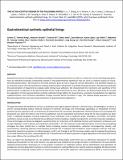| dc.contributor.author | LI, Junwei | |
| dc.contributor.author | Wang, Thomas | |
| dc.contributor.author | Shi, Yunhua | |
| dc.contributor.author | Jones, Alexis | |
| dc.contributor.author | Moussa, Zaina | |
| dc.contributor.author | Lopes, Aaron | |
| dc.contributor.author | Collins, Joy | |
| dc.contributor.author | Tamang, Siddartha M | |
| dc.contributor.author | Hess, Kaitlyn | |
| dc.contributor.author | Shakur, Rameen | |
| dc.contributor.author | Karandikar, Paramesh v | |
| dc.contributor.author | Lee, Jung Seung | |
| dc.contributor.author | Huang, Hen-Wei | |
| dc.contributor.author | Hayward, Alison M | |
| dc.contributor.author | Traverso, Carlo Giovanni | |
| dc.date.accessioned | 2020-08-26T14:43:45Z | |
| dc.date.available | 2020-08-26T14:43:45Z | |
| dc.date.issued | 2020 | |
| dc.identifier.issn | 1946-6242 | |
| dc.identifier.uri | https://hdl.handle.net/1721.1/126813 | |
| dc.description.abstract | Epithelial tissuesline the organs of the body, providing an initial protective barrieras well as a surface for nutrient and drug absorption. Here we identifiedenzymatic components present in the gastrointestinal epithelium that canserve as selective means for tissue-directed polymerization. We focusedon the small intestine, given its role in drug and nutrient absorption, and identified catalase as an essential enzyme with the potential to catalyze polymerization and growth of synthetic biomaterial layers. We demonstrated that the olymerization of dopamine by catalase yieldsstrong tissueadhesion. We characterizedthe mechanism and specificity of the polymerization in segments of the gastrointestinal tracts of pigs and human sex vivo. Moreover, we demonstrated proof-of-concept for application of these gastrointestinal synthetic epithelial linings(GSELs)for drug delivery, enzymatic immobilizationfor digestive supplementation, and nutritional modulation through transient barrier formationin pigs.This catalase-based approach to insitu biomaterial generationmay have broad indicationsfor gastrointestinal applications. | en_US |
| dc.publisher | American Association for the Advancement of Science | en_US |
| dc.relation.isversionof | https://stm.sciencemag.org/content/12/558/eabc0441 | en_US |
| dc.rights | Creative Commons Attribution 4.0 International license | en_US |
| dc.rights.uri | https://creativecommons.org/licenses/by/4.0/ | en_US |
| dc.source | Prof. Traverso | en_US |
| dc.title | Gastrointestinal synthetic epithelial linings | en_US |
| dc.type | Article | en_US |
| dc.identifier.citation | Li, Junwei et al. “Gastrointestinal synthetic epithelial linings.” Science Translational Medicine, 12, (2020) © 2020 The Author(s) | en_US |
| dc.contributor.department | Massachusetts Institute of Technology. Department of Chemical Engineering | en_US |
| dc.contributor.department | Massachusetts Institute of Technology. Division of Comparative Medicine | en_US |
| dc.contributor.department | Massachusetts Institute of Technology. Department of Mechanical Engineering | en_US |
| dc.contributor.department | Koch Institute for Integrative Cancer Research at MIT | en_US |
| dc.relation.journal | Science Translational Medicine | en_US |
| dc.eprint.version | Author's final manuscript | en_US |
| dc.type.uri | http://purl.org/eprint/type/JournalArticle | en_US |
| eprint.status | http://purl.org/eprint/status/PeerReviewed | en_US |
| dc.identifier.doi | https://stm.sciencemag.org/content/12/558/eabc0441 | |
| dspace.date.submission | 2020-08-21T14:59:17Z | |
| mit.journal.volume | 12 | en_US |
| mit.license | PUBLISHER_CC | |
| mit.metadata.status | Complete | |
